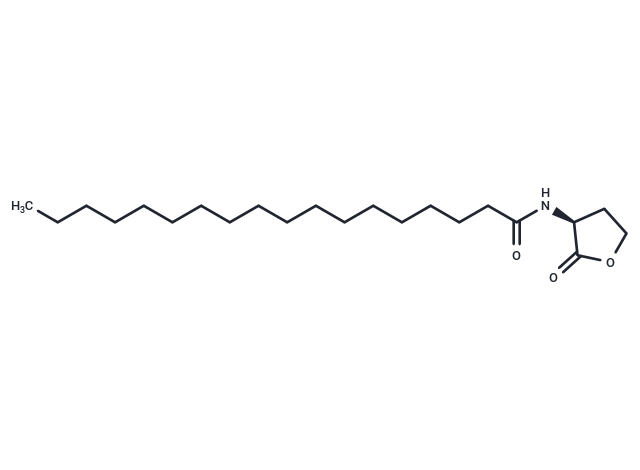- Remove All
 Your shopping cart is currently empty
Your shopping cart is currently empty
N-octadecanoyl-L-Homoserine lactone
C18-HSL is one of four lipophilic, long acyl side-chain-bearing N-acylated homoserine lactones (AHLs) produced by the LuxI AHL synthase homolog SinI, involved in quorum sensing signaling in S. meliloti, a nitrogen-fixing bacterial symbiont of the legume [M. sativa]. C18-HSL and other hydrophobic AHLs tend to localize in relatively lipophilic cellular environments and cannot diffuse freely through the cell membrane. These long-chain N-acylhomoserine lactones may be exported from cells by efflux pumps or transported between communicating cells via extracellular outer membrane vesicles. Quorum sensing, a regulatory system used by bacteria to control gene expression in response to cell density, manifests in phenotypes such as biofilm formation and virulence factor production. Coordinated gene expression is achieved through the production, release, and detection of small diffusible signal molecules called autoinducers, including AHLs, which vary in acyl group length (C4-C18), C3 substitution (hydrogen, hydroxyl, or oxo group), and the presence or absence of carbon-carbon double bonds, conferring signal specificity through LuxR family transcriptional regulators. Regulation of bacterial quorum sensing signaling to inhibit pathogenesis represents a novel approach to antimicrobial therapy in treating infectious diseases.

N-octadecanoyl-L-Homoserine lactone
| Pack Size | Price | Availability | Quantity |
|---|---|---|---|
| 5 mg | Inquiry | 35 days | |
| 10 mg | Inquiry | 35 days | |
| 25 mg | Inquiry | 35 days | |
| 50 mg | Inquiry | 35 days |
Product Introduction
| Description | C18-HSL is one of four lipophilic, long acyl side-chain-bearing N-acylated homoserine lactones (AHLs) produced by the LuxI AHL synthase homolog SinI, involved in quorum sensing signaling in S. meliloti, a nitrogen-fixing bacterial symbiont of the legume [M. sativa]. C18-HSL and other hydrophobic AHLs tend to localize in relatively lipophilic cellular environments and cannot diffuse freely through the cell membrane. These long-chain N-acylhomoserine lactones may be exported from cells by efflux pumps or transported between communicating cells via extracellular outer membrane vesicles. Quorum sensing, a regulatory system used by bacteria to control gene expression in response to cell density, manifests in phenotypes such as biofilm formation and virulence factor production. Coordinated gene expression is achieved through the production, release, and detection of small diffusible signal molecules called autoinducers, including AHLs, which vary in acyl group length (C4-C18), C3 substitution (hydrogen, hydroxyl, or oxo group), and the presence or absence of carbon-carbon double bonds, conferring signal specificity through LuxR family transcriptional regulators. Regulation of bacterial quorum sensing signaling to inhibit pathogenesis represents a novel approach to antimicrobial therapy in treating infectious diseases. |
| Molecular Weight | 367.57 |
| Formula | C22H41NO3 |
| Cas No. | 479050-96-9 |
| Relative Density. | no data available |
| Storage | Powder: -20°C for 3 years | In solvent: -80°C for 1 year | Shipping with blue ice. | ||||||||||
| Solubility Information | Chloroform: 0.5 mg/mL (1.36 mM), Sonication is recommended. | ||||||||||
Solution Preparation Table | |||||||||||
Chloroform
| |||||||||||
Calculator
In Vivo Formulation Calculator (Clear solution)
Dose Conversion
Tech Support
Keywords

Copyright © 2015-2025 TargetMol Chemicals Inc. All Rights Reserved.




